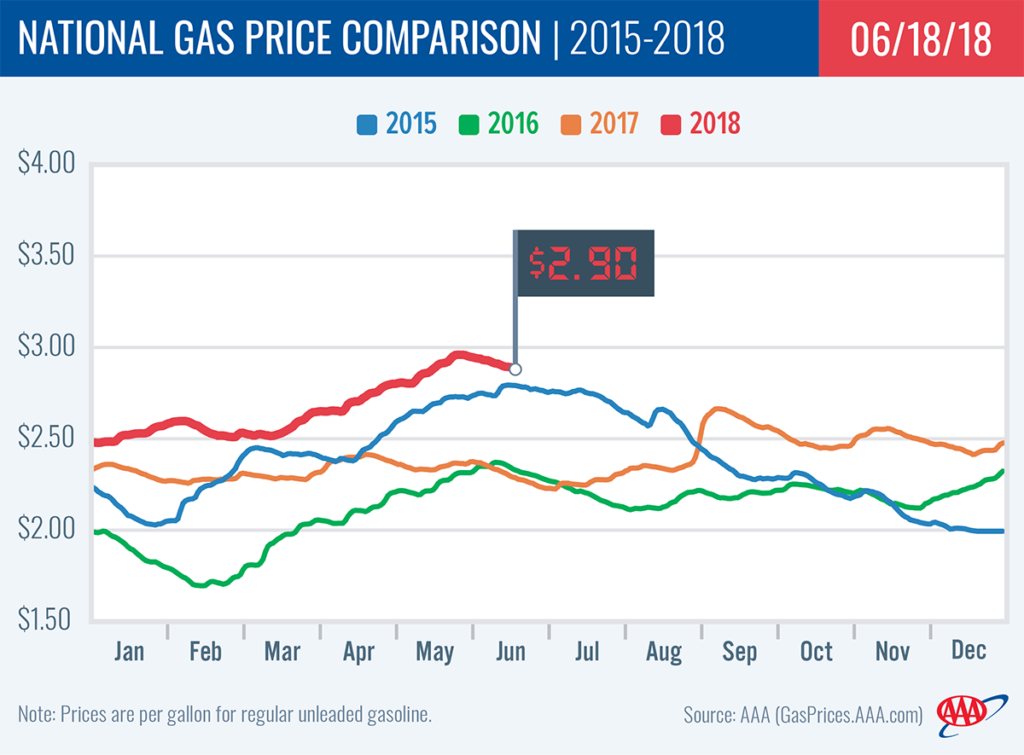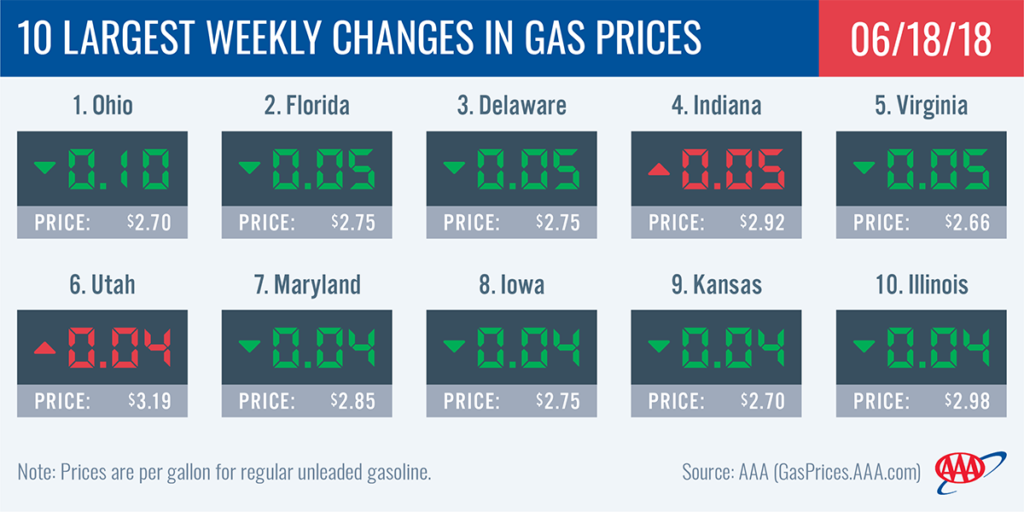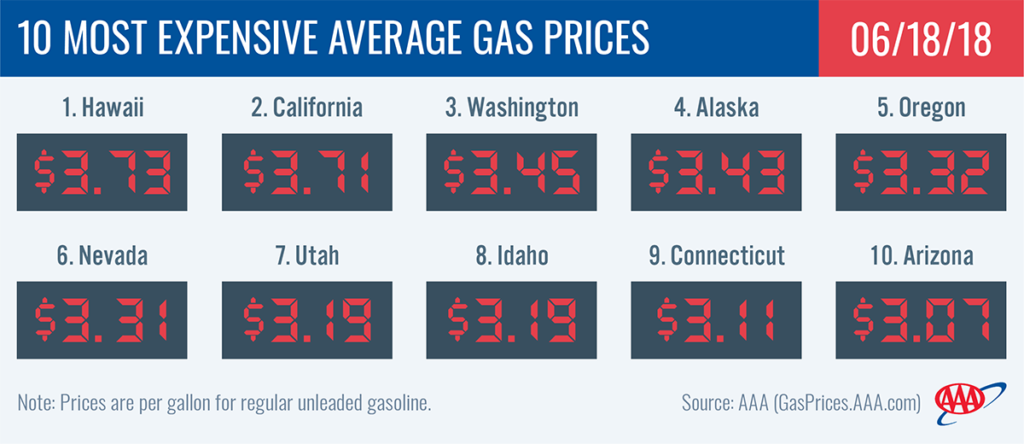At $2.85, the national gas price average is five cents cheaper than a week ago, 12-cents less than a month ago, but 58-cents more than a year ago. Gas prices have consistently been declining since Memorial Day. On the week, 49 states saw pump prices drop with and motorists in Indiana and Michigan saw double-digit declines.
Gas prices may be poised to drop even more following OPEC’s announcement that the cartel will increase production by 1 million b/d in the second half of 2018. However, that number may be revised closer to 600,000 b/d, as there is speculation that some producers – including Libya, Venezuela and Iran – will not be able to meet the quota increase. Regardless, the production increase is expected to decrease crude prices and in turn drive down gas prices later this year.
“The OPEC production increase will help to offset concerns of shrinking global supply caused by high global demand this year,” said Jeanette Casselano, AAA spokesperson. “For drivers in the U.S., pump prices likely will not see an impact immediately. Changes, and most likely not dramatic ones, are anticipated to hit pump prices late summer or early fall.”
The cartel made the production decision after the U.S., China and India voiced support for an increase to prevent an oil deficit that could stifle economic growth in the latter half of 2018. The production increase will occur ahead of this December’s expected dissolution of OPEC’s production reduction agreement, which has worked to reduce global oil supplies and increase the global price of crude since the beginning of 2017.
Quick Stats
- The nation’s top 10 least expensive markets are: South Carolina ($2.50), Mississippi ($2.54), Alabama ($2.54), Oklahoma ($2.56), Louisiana ($2.57), Arkansas ($2.60), Tennessee ($2.60), Virginia ($2.61), Ohio ($2.61) and Missouri ($2.63).
- The nation’s top 10 largest weekly decreases are: Indiana (-14 cents), Michigan (-13 cents), Ohio (-9 cents), Illinois (-8 cents), Kentucky (-7 cents), Missouri (-6 cents), Florida (-5 cents), Texas (-5 cents), Kansas (-5 cents) and South Carolina (-5 cents).
West Coast
Pump prices in the West Coast region are among the most expensive in the country: Hawaii ($3.73), California ($3.68), Washington ($3.44), Alaska ($3.41), Oregon (3.30), Nevada ($3.28) and Arizona ($3.05). On the week, the majority of prices in the region continue to decline, with California and Nevada leading the way at three cents each. Only Hawaii saw a slight increase by a penny.
According to the Energy Information Administration’s (EIA) petroleum report for the week ending on June 15, gasoline stocks in the region fell by 600,000 bbl and now sit at 30.9 million bbl. However, inventories are 1.7 million bbl higher than they were at this point last summer, which will likely help prices stabilize if there are any major supply disruptions in the region this week.
Great Lakes and Central
Six Great Lakes and Central states top the largest weekly decreases list: Indiana (-14 cents), Michigan (-13 cents), Ohio (-9 cents), Illinois (-8 cents), Kentucky (-7 cents) and Missouri (-6 cents). Gas prices are 3-14 cents cheaper than last Monday across the region except in South Dakota ($2.89) where prices remained stable. With the pump price drops, all state gas price averages are now under $3/gallon. Illinois carries the most expensive average at $2.91.
Not only are motorists in Ohio and Indiana seeing large declines in the last seven days, but gas prices are 30-cents and 26-cents cheaper, respectively, compared to last month. In fact, these two states and Michigan (-24 cents) lead the country in the biggest month-over-month decreases.
Inventories built slightly (81,000 bbl) and now sit at 52.6 million bbl. This is the third highest inventory level of all regions in the country, according to EIA data.
South and Southeast
South and Southeast states are seeing pump prices three to six cents cheaper on the week with Florida (-6 cents), Texas (-5 cents), South Carolina (-5 cents) and Georgia (-5 cents) seeing the largest decreases. In the region, state gas price averages range from as cheap as $2.50 in South Carolina to as expensive as $2.90 in New Mexico.
Compared to this time last year, gas prices are 49 to 70 cents more expensive: New Mexico (+70 cents), Oklahoma (+60 cents), Texas (+59 cents), Georgia (+59 cents), Arkansas (+57 cents), South Carolina (+57 cents) and Alabama (+55 cents). Florida (+49 cents) has the smallest year-over-year change.
Gasoline inventories made a substantial build with 3.4 million bbl, according to the latest EIA data. With a total of 83.6 million bbl, regional inventories sit at their highest mark since the end of March and about 1 million bbl ahead of this time last year.
Mid-Atlantic and Northeast
With a two-cent decrease on the week, Washington, D.C.’s gas price average falls below $3/gal, while Pennsylvania ($3.01), New York ($3.02) and Connecticut ($3.09) remain above this mark despite a four, three and three cent decrease, respectively. At a nickel, Maine’s gas price average saw the largest drop of any state in the Mid-Atlantic and Northeast region.
With gas prices nearly a quarter cheaper, Delaware (-24 cents) is seeing the largest month-over-month change of any states in the Mid-Atlantic and Northeast region. Other states seeing double-digit declines on the month: Maryland (-17 cents), Virginia (-15 cents), North Carolina (-13 cents), New Jersey (-13 cents), Tennessee (-13 cents), Pennsylvania (-12 cents), Maine (-11 cents), West Virginia (-11 cents) and Washington, D.C. (-10 cents).
EIA’s latest report shows that with a nearly 250,000 bbl build, regional inventories are sitting at some the highest levels of the year at 66 million bbl and contributing to price drops in the region.
Rockies
Wyoming (+2 cents) was the only state in the country to see an increase on the week. Among states in the Rockies region, Colorado (-3 cents) and Utah (-2 cents), saw the largest decrease, while gas price averages in Montana and Idaho decreased by a penny.
Gas prices are 62-cents more expensive in Utah and Wyoming than they were a year ago. Both states are among the top 12 in the country for largest year-over-year difference in gas prices. In the region, Colorado (+55 cents) has the smallest year-over-year change.
With a 129,000 bbl build, inventories sit just above 7 million bbl. According to EIA data, this is the highest inventory level seen since the end of April when levels measured at 7.2 million bbl.
Oil market dynamics
At the close of Friday’s formal trading session on the NYMEX, WTI increased $3.04 to settle at $68.58. Oil prices trended higher last week as the market digested OPEC’s announcement and analyzed its potential impact. This analysis is likely to continue influencing prices this week to determine if the supply increase will help to stabilize global crude prices.
On the domestic crude front, EIA’s report last week revealed that total crude inventories in the country decreased by 5.9 million bbl. Moreover, total crude exports hit their second highest rate since EIA began collecting this data at 2.4 million b/d. The rate was an increase of 344,000 b/d from the previous week. These findings highlight that domestic and global demand for crude from the U.S. remains high as OPEC works to increase the amount it supplies around the world.
In other news, the U.S. lost one oil rig last week, according to Baker Hughes, Inc., bringing the total number of rigs to 862. However, there are still 104 more rigs now than a year ago at the same time.
Motorists can find current gas prices along their route with the free AAA Mobile app for iPhone, iPad and Android. The app can also be used to map a route, find discounts, book a hotel and access AAA roadside assistance. Learn more at AAA.com/mobile.



